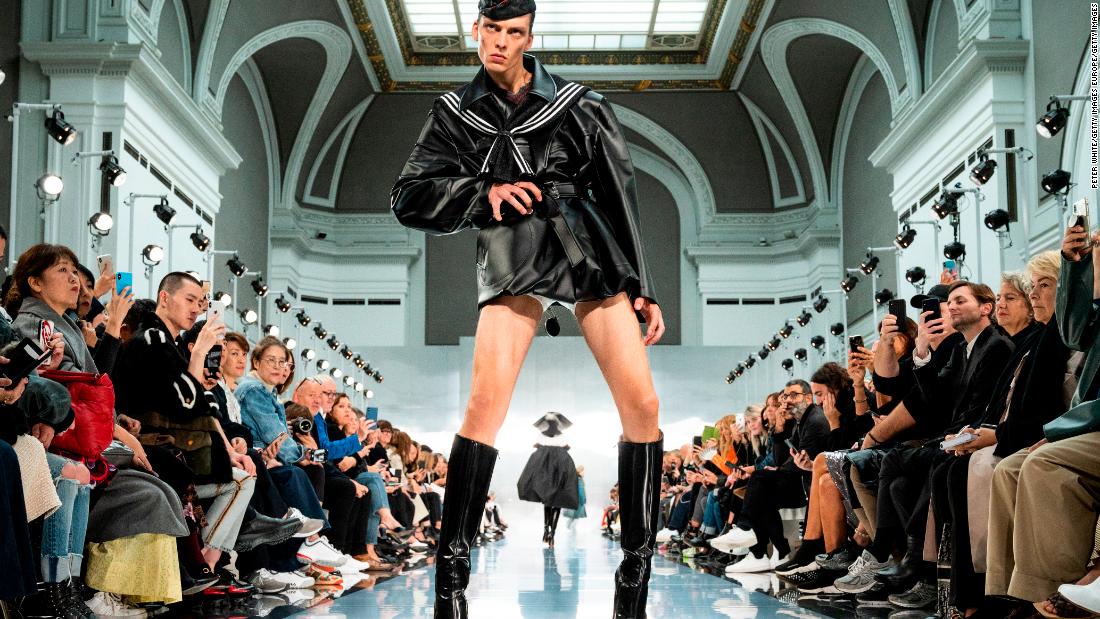[ad_1]
Following on from London, New York and Milan, Paris Fashion Week is the industry’s homestretch, ending a month-long run of elaborate shows and globetrotting.
The French capital is, of course, known for its glamour. But if there was an overarching theme this season, it was: sitting in the rain while collections were shown “en plein air.”
1/19 – Maison Margiela Spring-Summer 2020
Model Leon Dame became a viral meme as he energetically strutted down the runway during the Maison Margiela Spring-Summer 2020 show. Credit: Peter White/Getty Images
Picturesque as Paris may be, it’s always risky to show outdoors in late September. And the gray skies cast the city in more of a moody light than a romantic one.
The climate crisis also sat heavily in the air, and conversations in Paris weren’t just about fashion. Here are five of the wider talking points to emerge from the Spring-Summer 2020 shows.
Come rain or shine
In the gardens outside the Musée de Quai Branly, Lanvin countered a downpour on the morning of its show by offering guests large umbrellas, which proved more cumbersome than effective. Guests were also given headsets to listen to the show’s soundtrack, as models walked the runway in silence showcasing softly-sculpted jackets and pleated dresses with prints inspired by a vintage comic strip.

Lanvin Spring-Summer 2020 Credit: THOMAS SAMSON/AFP/AFP/Getty Images
American designer Rick Owens was also prepared for the weather, sending out emails to guests the day before his show on the Palais de Tokyo’s terrace informing them that ponchos would be provided. And Marine Serre pre-empted the rain by sending umbrellas out with invites for her show at a racecourse on the outskirts of Paris.
Y/Project left standing guests to brave the elements, though the Pont Alexandre III bridge offered cover to those lucky enough to be seated.
Making climate more than a buzzword
Designers are being forced to reconsider the sustainability of their practices. And with Paris Fashion Week coinciding with the United Nations first ever Climate Action Summit in New York, everyone was watching whether brands’ big talk would be put into action.

Dior Spring-Summer 2020 Credit: CHRISTOPHE ARCHAMBAULT/AFP/AFP/Getty Images
Dior set the bar high, setting its show amid a maze of 164 trees that will now be planted around Paris as part of a long-term bio-diversity project. The show was built around a zero-waste policy, and the entire set will be recycled (or re-planted).

Stella McCartney Spring-Summer 2020 Credit: THOMAS SAMSON/AFP/AFP/Getty Images
Stella McCartney, who was appointed LVMH chairman Bernard Arnault’s special advisor on green initiatives in July, presented her most sustainable collection to date. Three-quarters of the garments were made using “zero-impact” fabrics, such as regenerated cashmere, hemp and sustainable raffia (as seen in McCartney’s logo handbags).
Chloe’s approach, meanwhile, was to do away with seasonal trends and instead focus on wardrobe staples, with signatures pieces from the brand simply refined for each new season.
Fashion shows as spectacles
With increased social media presence and more shows being live-streamed, brands are reinventing the runway experience. Fantastical productions can leave a significant digital imprint.
Rick Owens’s bubble-blowing models were poetic and ethereal. Dotted around the fountain of the Palais de Tokyo, they wore ceremonial robes while releasing huge bubbles from long wands while other models walked by in geometric headdresses and voluminous coats.

Thom Browne Spring-Summer 2020 Credit: FRANCOIS GUILLOT/AFP/AFP/Getty Images
Meanwhile, Thom Browne’s seersucker cotton set provided a theatrical backdrop for a collection that drew heavily on 18th-century France, Marie Antoinette and ’80s punk. There were many magical moments, including a model in a pannier dress pushing a pram to the “Teletubbies” theme song.
Then, of course, there was German model Leon Dame, who closed the Maison Margiela show with a fierce strut that had guests grabbing for their phones. Dame’s hunched-over stomp and intense stare instantly went viral.
Seventies redux
The 1970s was a tumultuous decade that saw political instability, the rise of the New Right and marginalized communities fighting for equal rights — all of which may still resonate today.
Designers nodded to the era’s aesthetics, while focusing on youthful ideas and expressions of hope for the future. Ralph and Russo’s show was an ode to the lighthearted glamor of Miami Beach, complete with a series of pastel tie-dyed silk kimonos and fluid maxi-dresses.
At Celine, Hedi Slimane’s take on the French boho girl possessed a harder edge, with flared jeans paired with Converse-style trainers as well as shaggy fur coats, midi prairie dresses embellished with sequins and blazers worn over shirts and paired with aviator sunglasses and scowls.
Dries Van Noten’s epic collaboration with Christian Lacroix
A collaboration that stole the spotlight — not only at Paris, but of the entire month — was the unexpected partnership between Belgian designer Dries Van Noten and French couturier Christian Lacroix, who stepped away from the industry when his eponymous brand was sold a decade ago.

Dries Van Noten Spring-Summer 2020 Credit: Francois Mori/AP
“It was such a surprise to see two different designers coming together,” British fashion critic Suzy Menkes told CNN.
“One, who is from Northern Europe (and) who we think of as slightly closed, and (the other is) Christian Lacroix, who is basically in theater and ballet and from the south of France. So, completely different characters — and it was a very exciting moment,”
Each designer brought their own aesthetic to the collection, and then they meshed them together, reworking the Van Noten tropes in the lexicon of Lacroix. It was a colorful collection of cerebral elegance, with an injection of joie de vivre in the form of ribbons, polka dots, ruffles, puffed sleeves and zebra print.
Many of the looks were layered over white tank tops and jeans, a nod to Van Noten’s “Antwerp Six” era which, in the ’90s, subverting everything Lacroix stood for: abundance, flamboyance and camp. But the collaboration was not a competition but a dialogue that wove together both designers’ work.
[ad_2]
Source link

